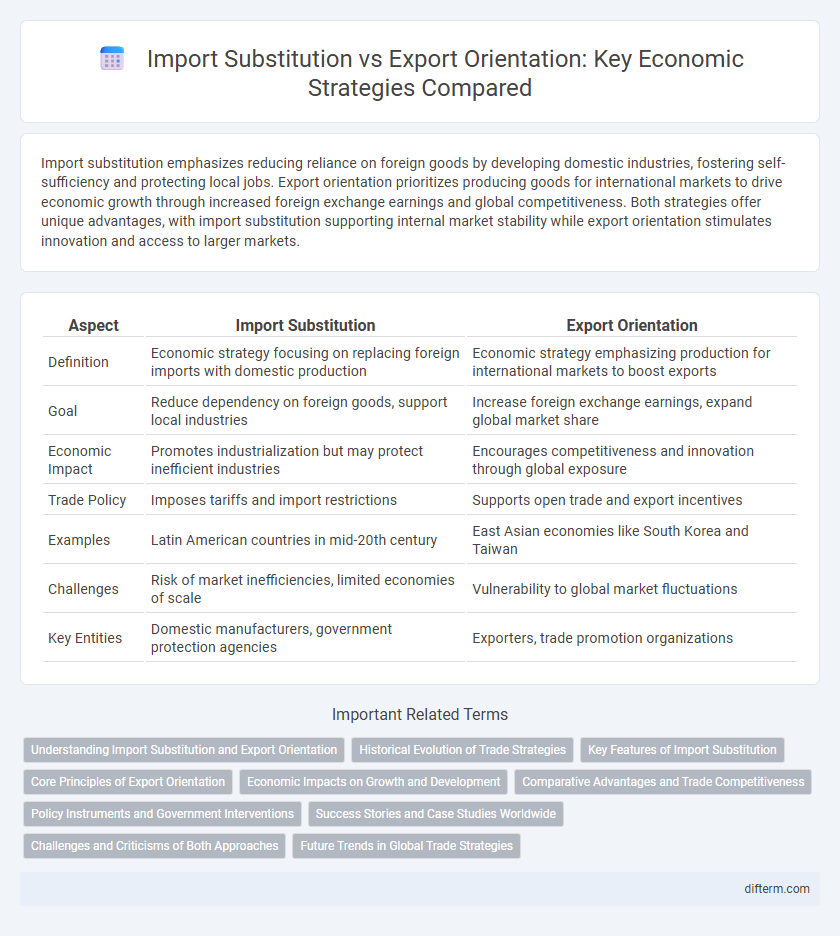Import substitution emphasizes reducing reliance on foreign goods by developing domestic industries, fostering self-sufficiency and protecting local jobs. Export orientation prioritizes producing goods for international markets to drive economic growth through increased foreign exchange earnings and global competitiveness. Both strategies offer unique advantages, with import substitution supporting internal market stability while export orientation stimulates innovation and access to larger markets.
Table of Comparison
| Aspect | Import Substitution | Export Orientation |
|---|---|---|
| Definition | Economic strategy focusing on replacing foreign imports with domestic production | Economic strategy emphasizing production for international markets to boost exports |
| Goal | Reduce dependency on foreign goods, support local industries | Increase foreign exchange earnings, expand global market share |
| Economic Impact | Promotes industrialization but may protect inefficient industries | Encourages competitiveness and innovation through global exposure |
| Trade Policy | Imposes tariffs and import restrictions | Supports open trade and export incentives |
| Examples | Latin American countries in mid-20th century | East Asian economies like South Korea and Taiwan |
| Challenges | Risk of market inefficiencies, limited economies of scale | Vulnerability to global market fluctuations |
| Key Entities | Domestic manufacturers, government protection agencies | Exporters, trade promotion organizations |
Understanding Import Substitution and Export Orientation
Import substitution involves developing domestic industries to reduce reliance on foreign goods by producing locally what was previously imported, thereby promoting self-sufficiency and protecting nascent industries through tariffs and quotas. Export orientation focuses on integrating national economies into global markets by producing goods for international consumers, leveraging comparative advantage, and fostering competitive industries through open trade policies. Both strategies impact economic growth, industrial diversification, and employment, but export orientation often drives innovation and access to larger markets more effectively than import substitution.
Historical Evolution of Trade Strategies
Import substitution industrialization (ISI) emerged prominently in Latin America during the mid-20th century as nations sought to reduce dependency on foreign goods by fostering domestic production through protective tariffs and state intervention. In contrast, export-oriented industrialization (EOI) gained traction in East Asian economies like South Korea and Taiwan from the 1960s onward, emphasizing integration into global markets by promoting competitive exports and attracting foreign investment. The historical evolution of these trade strategies illustrates a shift from inward-looking policies aimed at self-sufficiency to outward-facing approaches focused on global trade participation and economic growth.
Key Features of Import Substitution
Import substitution emphasizes reducing dependency on imported goods by promoting domestic production through protective tariffs, subsidies, and government intervention. It often involves developing local industries to meet national demand, aiming to foster self-sufficiency and reduce foreign exchange outflows. Key features include import restrictions, focus on creating infant industries, and state-led economic planning to stimulate domestic manufacturing.
Core Principles of Export Orientation
Export orientation emphasizes producing goods and services primarily for international markets to boost foreign exchange earnings and economic growth. Core principles include leveraging comparative advantage, investing in technological innovation, and enhancing product quality to meet global standards. This approach fosters competitive industries, encourages economies of scale, and integrates the domestic economy into global value chains.
Economic Impacts on Growth and Development
Import substitution fosters domestic industries by reducing foreign dependency, which can stimulate local job creation and diversify the economy but may lead to inefficiencies due to limited competition. Export orientation drives economic growth through access to larger markets, increased foreign exchange earnings, and technology transfer, often resulting in higher productivity and innovation. Balancing these strategies is crucial, as heavy reliance on import substitution can hinder global integration, while export orientation may expose the economy to external shocks and demand fluctuations.
Comparative Advantages and Trade Competitiveness
Import substitution focuses on developing domestic industries to reduce dependency on foreign products, leveraging a country's unique resources and capabilities to build comparative advantages internally. Export orientation emphasizes competitive integration into global markets by capitalizing on comparative advantages related to cost efficiency, technological innovation, and skilled labor to boost trade competitiveness. Countries adopting export-oriented strategies often achieve higher economic growth through scale economies and enhanced participation in international value chains.
Policy Instruments and Government Interventions
Import substitution policies utilize tariffs, quotas, and subsidies to protect domestic industries and reduce foreign dependency, fostering local production. Export orientation strategies emphasize trade liberalization, export incentives, and foreign direct investment promotion to enhance global competitiveness and market access. Government interventions in both approaches involve regulatory reforms, infrastructure development, and targeted financial support to align industrial growth with national economic objectives.
Success Stories and Case Studies Worldwide
Import substitution and export orientation have driven economic transformation in diverse regions, with import substitution achieving notable success in Latin American countries like Brazil by fostering domestic industries and reducing dependency on foreign goods. Export-oriented strategies propelled rapid growth in East Asian economies such as South Korea and Taiwan, leveraging competitive advantages in manufacturing and technology to become global exporters. Case studies reveal that strategic government policies, infrastructure investment, and innovation ecosystems are critical in both approaches to stimulate sustainable economic development.
Challenges and Criticisms of Both Approaches
Import substitution faces challenges such as inefficiencies, protectionism leading to reduced competitiveness, and limited access to advanced technologies. Export orientation often encounters dependency on volatile global markets, vulnerability to external shocks, and pressure to maintain low production costs impacting labor standards. Both strategies can struggle with balancing short-term economic goals and sustainable long-term growth.
Future Trends in Global Trade Strategies
Import substitution aims to reduce dependency on foreign goods by fostering domestic production, while export orientation prioritizes integrating into global markets to drive economic growth. Future trends indicate a hybrid approach, leveraging technology and innovation to balance self-sufficiency with competitive export capabilities. Emerging markets increasingly adopt digital trade platforms and sustainable practices to enhance supply chain resilience and global competitiveness.
Import substitution vs Export orientation Infographic

 difterm.com
difterm.com